News
Behind the Headlines
Two-Cents Worth
Video of the Week
News Blurbs
Articles
Testimony
Bible Questions
Internet Articles (2015)
Internet Articles (2014)
Internet
Articles (2013)
Internet Articles (2012)
Internet Articles (2011)
Internet Articles (2010)
Internet Articles
(2009)
Internet Articles (2008)
Internet Articles (2007)
Internet Articles (2006)
Internet Articles (2005)
Internet Articles (2004)
Internet Articles (2003)
Internet Articles (2002)
Internet Articles (2001)


 he sparring match between the creationists and the evolutionists is heating up again just as it did in Tennessee in 1925. Several States have now introduced, or passed laws that will bring creationism back into the classrooms as an alternate, and more plausible, "theory" than the theory of evolution that is currently taught as fact in America's schools.
he sparring match between the creationists and the evolutionists is heating up again just as it did in Tennessee in 1925. Several States have now introduced, or passed laws that will bring creationism back into the classrooms as an alternate, and more plausible, "theory" than the theory of evolution that is currently taught as fact in America's schools.
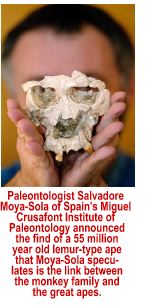 In a timely and seemingly subtle "rebuttal" of the creationist argument, the scientific community announced to the global media on November 15, 2004 that a team of paleontologists headed by Salvadore Moya-Sola, digging in a small basin near the village of Els Hostalets de Pierola, about 20 miles from Barcelona, Spain, unearthed what they cautiously deferred from calling the "missing link" between the monkey family and the great apes, preferring instead to call it a "grandfather link " in the whole evolutionary chain, and suggesting it was just one more species on the evolutionary path to man.
In a timely and seemingly subtle "rebuttal" of the creationist argument, the scientific community announced to the global media on November 15, 2004 that a team of paleontologists headed by Salvadore Moya-Sola, digging in a small basin near the village of Els Hostalets de Pierola, about 20 miles from Barcelona, Spain, unearthed what they cautiously deferred from calling the "missing link" between the monkey family and the great apes, preferring instead to call it a "grandfather link " in the whole evolutionary chain, and suggesting it was just one more species on the evolutionary path to man.
The discovery came at time when the scientific community needed to find a transitional link of some sort in the evolutionary chain to help bolster Charles Darwin's tenuous theory of evolution. If scientific evidence 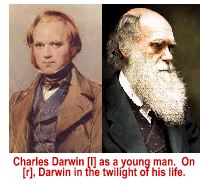 (science jargon for "unsupported speculation" based on paleontological smoke and mirrors) confirms that Pierolapithecus catalaunicus—as the newly discovered lemur-type tree climber was named—then a reasonable argument could be made that an evolutionary spiral from the lower forms of life, through the ape family to the great apes and ultimately to man, does exist. "It is a starting point," Moya-Sola argued, "the first [monkey] fossil to show characteristics of a modern great ape." What made the discovery exciting to the team was that the fossil shares characteristics with both monkey and ape. It has a flat chest and flat face like the great apes, and shoulder blades that are fixed to the back rather than the sides, a spinal cord suited for vertical climbing, and wrists that made it easy to grab and hold branches and tree trunks.
(science jargon for "unsupported speculation" based on paleontological smoke and mirrors) confirms that Pierolapithecus catalaunicus—as the newly discovered lemur-type tree climber was named—then a reasonable argument could be made that an evolutionary spiral from the lower forms of life, through the ape family to the great apes and ultimately to man, does exist. "It is a starting point," Moya-Sola argued, "the first [monkey] fossil to show characteristics of a modern great ape." What made the discovery exciting to the team was that the fossil shares characteristics with both monkey and ape. It has a flat chest and flat face like the great apes, and shoulder blades that are fixed to the back rather than the sides, a spinal cord suited for vertical climbing, and wrists that made it easy to grab and hold branches and tree trunks.
To date, with over 8.5 billion fossil examined, not a single transitional fossil has ever been found.  For over 100 years, Coelacanth was believed to be a transitional fossil, but it was discredited in 1938. Coelacanth was a Devonian Period crossoptergian [lobe-finned fish] that scientists believed was the link between fish and amphibians. It was thought to have become extinct during the Cretaceous Period—65 million years ago.
For over 100 years, Coelacanth was believed to be a transitional fossil, but it was discredited in 1938. Coelacanth was a Devonian Period crossoptergian [lobe-finned fish] that scientists believed was the link between fish and amphibians. It was thought to have become extinct during the Cretaceous Period—65 million years ago.
In 1938 a living Coelacanth was caught in the waters between Africa and Madagascar. Coelacanth remained unchanged for 350 million years. 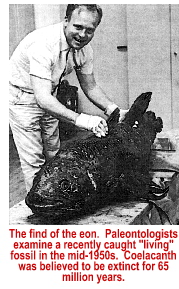 The living fossil became an embarrassment to the scientific community which had, for years, insisted that coelacanth developed membranous lungs when it rose to the surface of the primeval sea, and developed legs as it moved onto the land. Unfortunately for the paleonanthropologists, the coelacanth which have been netted in the Indian Ocean and eaten by native fishermen for over a half century do not have lungs, nor did their fins evolve into legs.)
The living fossil became an embarrassment to the scientific community which had, for years, insisted that coelacanth developed membranous lungs when it rose to the surface of the primeval sea, and developed legs as it moved onto the land. Unfortunately for the paleonanthropologists, the coelacanth which have been netted in the Indian Ocean and eaten by native fishermen for over a half century do not have lungs, nor did their fins evolve into legs.)
The evolutionary narrative is always based on speculative assumption that has never been supported by any tangible evidence. Every now and then the speculative narrative concerning these evolutionary leaps catch up with the evolutionists and they find themselves embarrassed beyond words.
That is why the evolutionists are cautiously enthusiastic and guarded in their pronouncements of finding transitional links between various species, or between ape and man. "There are many, many links in the evolutionary chain," paleoanthropologist Carol V. Ward of the University of Missouri at Columbia speculated,  "This may be the last common ancestor between great apes and humans, or not. More likely not. But that ancestor is going to be a lot like this fossil."
"This may be the last common ancestor between great apes and humans, or not. More likely not. But that ancestor is going to be a lot like this fossil."
Moya-Sola speculated that the 83 bone fragments, pieces of the skull, vertebrae, ribs, wrist bones and other fragments all came from the same creature. Assuming that all fossils in one fossil bed came from the same creature or source and the same paleontological time has been problematic for paleoanthropoligists since every pronouncement of an evolutionary link between the great apes and man eventually has been scientifically discredited. But that has not stopped the academic community from continuing to teach that overwhelming and indisputable scientific evidence proves that man is a product of evolution and not creation. In point of fact, the opposite is true. The fossil records themselves say evolution is a false theory.
In February, 1922 an amateur geologist named Harold Cook found a fossilized tooth—a molar—while digging in a quarry near Omaha in 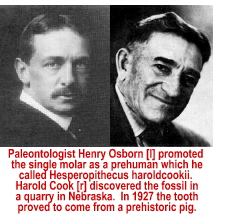 Snake Creek, Nebraska. Cook, who knew he'd found something important, took the fossil to Henry Fairfield Osborn, one of the country's leading paleontologists. Osborn held a press conference and announced that the tooth came from a prehistoric member of the human family that he named Hesperopithecus haroldcookii—after the man who made the historic find. Osborn presented the media with a sketch of what Hesperopithecus haroldcookii—Nebraska Man—would look like when, and if, a complete skeleton was ever found. When the complete skeleton was found, in 1927, Nebraska Man proved to be a prehistoric pig. Nebraska Man, the first of many embarrassments to the evolutionists of the day, might have faded into oblivion had it not been for a related event that happened in 1925 in Dayton, Tennessee. In spite of the indisputable evidence that Hesperopithecus was a pig, Nebraska Man remains inscribed as one of the links in man's family tree in many of the textbooks used by civic biology and science teachers all across this country.
Snake Creek, Nebraska. Cook, who knew he'd found something important, took the fossil to Henry Fairfield Osborn, one of the country's leading paleontologists. Osborn held a press conference and announced that the tooth came from a prehistoric member of the human family that he named Hesperopithecus haroldcookii—after the man who made the historic find. Osborn presented the media with a sketch of what Hesperopithecus haroldcookii—Nebraska Man—would look like when, and if, a complete skeleton was ever found. When the complete skeleton was found, in 1927, Nebraska Man proved to be a prehistoric pig. Nebraska Man, the first of many embarrassments to the evolutionists of the day, might have faded into oblivion had it not been for a related event that happened in 1925 in Dayton, Tennessee. In spite of the indisputable evidence that Hesperopithecus was a pig, Nebraska Man remains inscribed as one of the links in man's family tree in many of the textbooks used by civic biology and science teachers all across this country.
On March 21, 1925 the legislature in the State of Tennessee passed The Butler Act—the nation's first Creation Law—making it a misdemeanor for any school teacher in the State to teach Darwin's theories on evolution—or any other view— that denied Divine creation. The American Civil Liberties Union [ACLU], which was founded in 1920 and was still floundering in the murky waters of obscurity five years later, saw the Volunteer State's new law as a means of gaining national attention for the ACLU.
During the spring of 1925, the ACLU began running classified ads in many of the rural newspapers in the State,  seeking a school teacher who would be willing to become the sacrificial lamb to test the new law in court. The resulting court action, more commonly known as either the Scopes Trial or the Monkey Trial, was probably the first court case in American history where the defense actually prepared its case before the crime was committed.
seeking a school teacher who would be willing to become the sacrificial lamb to test the new law in court. The resulting court action, more commonly known as either the Scopes Trial or the Monkey Trial, was probably the first court case in American history where the defense actually prepared its case before the crime was committed.
 John Thomas Scopes was a 24-year old freckle-faced science teacher at Dayton High School when he answered the ACLU advertisement. Scopes was in dire financial straits, and desperately needed the $100 offered by the ACLU. A few days later Scopes was interviewed by three local attorneys and two ACLU attorneys over ice cream sodas at Robinson's Drug Store on Main Street in Dayton.
John Thomas Scopes was a 24-year old freckle-faced science teacher at Dayton High School when he answered the ACLU advertisement. Scopes was in dire financial straits, and desperately needed the $100 offered by the ACLU. A few days later Scopes was interviewed by three local attorneys and two ACLU attorneys over ice cream sodas at Robinson's Drug Store on Main Street in Dayton.
On May 25, 1925 Scopes entered the history of the United States. Stepping in front of his class with a copy of Hunters' Civic Biology—the State-mandated textbook—he said: "We have learned that animal forms can be arranged so as to begin with the simple one-celled forms, and culminate with a group which includes man himself..." Within a matter of days, a special grand jury was impaneled and Scopes was indicted. 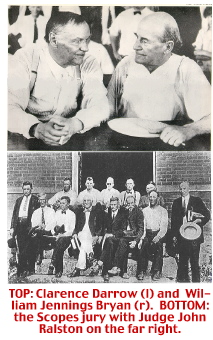 William Jennings Bryan, former Secretary of State under Woodrow Wilson (and a three-time Democratic candidate for President of the United States) volunteered to prosecute the case because of his Christian belief in creationism. Two of Scopes' three ACLU attorneys were among those who met with him at Robinson's Drug Store: Dudley Field Malone and Arthur Garfield Hays. Clarence Darrow joined the case pro bono when Bryan joined the prosecution.
William Jennings Bryan, former Secretary of State under Woodrow Wilson (and a three-time Democratic candidate for President of the United States) volunteered to prosecute the case because of his Christian belief in creationism. Two of Scopes' three ACLU attorneys were among those who met with him at Robinson's Drug Store: Dudley Field Malone and Arthur Garfield Hays. Clarence Darrow joined the case pro bono when Bryan joined the prosecution.
It was the tactics Clarence Darrow used, with respect to Nebraska Man, that is worth mention here. Bryan brought in scores of preachers and Christian leaders to testify of their belief in God and the Christian faith's teaching that God created Earth and everything on it, Darrow had a shortage of witnesses since Judge John Ralston—who opened the Scopes Trial by reading the first 27 verses in the book of Genesis—disqualified every "expert" on Darrow's witness list. Left with nobody to call except Bryan himself, Darrow managed to produce one witness: the tooth from Nebraska Man as concrete, genuine evidence that evolution, not creationism, was the only acceptable theory for man's presence on Earth. It didn't matter. Scopes lost. It took the jury eight minutes to render a verdict. Two years later when the entire skeleton of Nebraska Man was discovered, it proved to be nothing more than a prehistoric pig. The headlines, however, denouncing Nebraska Man as an embarrassing fraud, were not as large or as prominent as those announcing its discovery. And, apparently no school teachers or textbook publishers read the nation's newspapers that day.
Nebraska Man was not deliberate fraud. However, the Piltdown Man, which would make headlines three decades later, was. The scam began in 1908 when a British solicitor and amateur archeologist, Charles Dawson, asked two road workers digging a gravel trench along a road at Piltdown, near Sussex, England to keep an eye out for any unusual artifax—including any old bones which he might be willing to purchase. They found a fragment of something that looked like a coconut shell and took it to Dawson.
Dawson realized the "coconut shell" was actually a fairly old skull cap. In the fall of 1911 Dawson claims he recovered a large piece of cranium bone a the same Piltdown location and decided it belonged to the same individual who had previously wore the 1908 skull cap.  He also found what ultimately turned out to be a modern canine tooth that Dawson stained and "aged" to make it appear as old as the skull cap that had been found by the road workers in 1908.
He also found what ultimately turned out to be a modern canine tooth that Dawson stained and "aged" to make it appear as old as the skull cap that had been found by the road workers in 1908.
Dawson also found the jaw of an orangutan, which he also "aged" to make it appear as old as the fossilized skull cap he received from the road workers in 1908. Dawson then "salted" the Piltdown site with those artifacts, plus a fossilized beaver and some mastodon teeth. Dawson's Piltdown site was now ready for discovery.
In February, 1912 because he needed someone reputable to authenticate his find, Dawson approached a friend, Arthur Smith Woodward who was not only a paleoichtholgist, but who was also custodian of the British Museum's natural history department. Woodward—who also wanted someone reputable to authenticate the site, enlisted a Jesuit priest, Teilhard de Chardin, who was a much respected paleontologist, to assist in the dig.
And, of course, over a period of weeks, they found all the fossil evidence planted by Dawson. 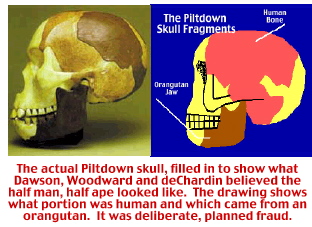 After analyzing the specimens, they concluded the skull and jawbone fragments were from one being—an ancient human ancestor who clearly was related to both man and ape. Woodward and de Chardin were convinced they had found the missing link. They believed the Piltdown Man provided conclusive proof that Darwin was right, and that man did evolve from the ancestors of modern apes. The find was announced in December, 1912. Woodward and Dawson officially presented Piltdown Man to the Geological Society in London, announcing that the skeletal remains were over 500 thousand years old.
After analyzing the specimens, they concluded the skull and jawbone fragments were from one being—an ancient human ancestor who clearly was related to both man and ape. Woodward and de Chardin were convinced they had found the missing link. They believed the Piltdown Man provided conclusive proof that Darwin was right, and that man did evolve from the ancestors of modern apes. The find was announced in December, 1912. Woodward and Dawson officially presented Piltdown Man to the Geological Society in London, announcing that the skeletal remains were over 500 thousand years old.
In 1953, a team of three scientists: Kenneth Oakley, Wilfred Le Gros Clark and Joseph Weiner performed a fluorine-based test on the skull and made a shocking discover. The skull cap of Piltdown Man was about 50 thousand years old. But the jaw—which had been stained with potassium dichromate to make it appear ancient—was only a few decades old. Once again, the missing link that evolutionists needed to prove that Darwin's theories were correct, was discredited. Once the story broke in the British media, it was learned that Dawson had trafficked in fake artifacts for years. But Dawson, who died in 1916, never had to answer for his fraud on the scientific community.
Most fossil records, however, are not frauds—deliberate or otherwise. But evidence that links companion forms of life simply do not exist and will never be found quite simply because life did not develop due to an evolutionary springboard. If it did, transitional lifeforms would be abundant among the fossil records. Furthermore, the scientific community faces an evolutionary dilemma dearth of evidence simply because a botanist named Charles Darwin advanced a flawed theory on the origin and development of life species which eager, atheistic scientists accepted as fact.
 Java Man was also presented by its discoverer—who had no scholarly credentials as a paleontologist—as the missing link. It was a fraud in the sense that Dutch physician Dr. Eugene Dubois, who discovered a ancient skullcap that contained anthropoid eye ridges along the Solo River near Trinil, Sumatra in 1891, also found—a year later—what appeared to be a human femur in the same vicinity where he found the skull cap a year before. Still later, in the same area, he found three fossil teeth.
Java Man was also presented by its discoverer—who had no scholarly credentials as a paleontologist—as the missing link. It was a fraud in the sense that Dutch physician Dr. Eugene Dubois, who discovered a ancient skullcap that contained anthropoid eye ridges along the Solo River near Trinil, Sumatra in 1891, also found—a year later—what appeared to be a human femur in the same vicinity where he found the skull cap a year before. Still later, in the same area, he found three fossil teeth. 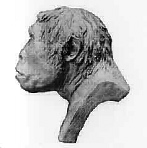 Dubois decided that all of his specimens came from the same prehistoric individual, which he named Pithecanthropus erectus (the erect ape man), or as its become known today: Java Man.
Dubois decided that all of his specimens came from the same prehistoric individual, which he named Pithecanthropus erectus (the erect ape man), or as its become known today: Java Man.
Dubois brought his find to the International Congress of Zoology in 1895. Pithecanthropus erectus was met with a great deal of skepticism and a divided opinion on the merits of his discovery. Some of the zoologists believed the skull cap, which was decidedly anthropoid, could not have belonged to the same individual as the femur, which was decidedly human. And because Dubois failed to mention it, none of the delegates at the Congress knew that Dubois had also discovered two human skulls at the same archaeological level at nearby Wadjak in 1890. The Dubois find clearly indicates that humans and the "owner" of the skull cap co-existed at the same time in Sumatra.
Dubois, in fact, concealed that information until 1927 when Dr. Davidson Black, professor of anatomy at Peking's Union Medical College announced the discovery of a new species of fossil man, which he called Sinathropus pekinensis—Peking Man. 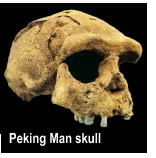 A year later, an anterior skull portion of Sinathropus was found in China, followed by additional skulls of both Sinathropus and Pithecanthropus in China and the East Indies, respectively. All of the skull caps had one thing in common. Each contained a hole through the top or back of the skull. It was apparent to the researchers that the holes existed to suck out the brains—all of the "individuals" were victims of cannibalism. Because the remains of cooking hearths and primitive stone tools were found at the sites where skeletal remains were found, it was assumed that both Sinathropus and Pithecanthropus were intelligent subhumans when in fact they were not the tool-making hunters—they were the food. Evidence amassed over the past thirty years support the view that both Java Man and Peking Man were animals: gibbons, gorillas, organutans or perhaps even large chimpanzees whose brains were viewed as a dietary treat—much like a dessert after a sumptuous meal.
A year later, an anterior skull portion of Sinathropus was found in China, followed by additional skulls of both Sinathropus and Pithecanthropus in China and the East Indies, respectively. All of the skull caps had one thing in common. Each contained a hole through the top or back of the skull. It was apparent to the researchers that the holes existed to suck out the brains—all of the "individuals" were victims of cannibalism. Because the remains of cooking hearths and primitive stone tools were found at the sites where skeletal remains were found, it was assumed that both Sinathropus and Pithecanthropus were intelligent subhumans when in fact they were not the tool-making hunters—they were the food. Evidence amassed over the past thirty years support the view that both Java Man and Peking Man were animals: gibbons, gorillas, organutans or perhaps even large chimpanzees whose brains were viewed as a dietary treat—much like a dessert after a sumptuous meal.
Just before he died, Dubois refuted his own claims that he had discovered the missing link, insisting what he found was simply the skull of a large gibbon. Science, however, has refused to accept or even acknowledge Dubois' deathbed confession. Today, both Pithecanthropus and Sinathropus are snugly nestled in the evolutionary tree as indisputable evidence than man did, indeed, evolve from the apes. 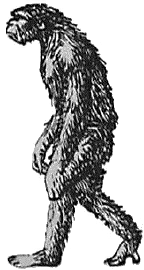 It suits the evolutionist to use only that portion of the fossil records that best support his view and ignore the volumes of fossil evidence which question it.
It suits the evolutionist to use only that portion of the fossil records that best support his view and ignore the volumes of fossil evidence which question it.
Most textbooks used in America's schools today show an evolutionary chain which extends from Pliopithecus (a primitive gibbon) to Proconsul (another gibbon), to Dryopthecus (whose only remains are a few teeth and one jaw fragment), to Oreopithecus (an ape), to Ramapithecus (whose only remains, like Dryopithecus, consist of a few teeth, a palate and a jaw fragment), to Australopithecus erectus and Australopithecus Africanus, to Pithecanthropus and Sinathropus, and then, on to man. Once man was achieved, evolution magically stopped. Today, evolutionists insist that evolution is still progressing—only now, what is evolving is man's intelligence. Logic dictates that we reject that notion since most people today believe wholly, or at least in part, in evolution. You really can't be too intelligent if you have fallen for that one.
Evolutionists would have us believe that in the very complicated and organized process of natural selection, that complex life continued to evolve from primitive insects into more complex life forms, ending with man at the top of the ladder—and then stopping. Human life depends on every rung of the ladder below it for its existence, from the food we eat to the air we breathe. We are the king of the mountain. We are also totally unnecessary in the natural process that resulted in our "creation." Man is, in fact, the only totally unnecessary thing in nature. Think about it.
Whenever suggested evolutionary links are studied in an unbiased manner with all of the available fossil evidence found at the fossil site examined collectively, each prospective progenitor of man has proven to be an anthropoid. If Darwin's observations on the Galapagos Islands concerning the "acquired characteristics" of the species studied were correct, proof would be amply available in the form of fossil records that would necessarily show some evidence of transitional forms (i.e., the missing links between species). But, as noted earlier, with 8.5 billion fossils in the "evidence bank," not a single transitional lifeform exists.
With so much data that overwhelmingly disputes evolution as a viable scientific theory, one wonders why Darwin's theories are even considered as theory today by the scientific community, let alone accepted as fact in face of mountains of evidence that dispute it. Evolution is accepted as fact because evolution is essential to the philosophy of humanism. If man is simply the byproduct of his environment, he is master of his existence and, thus, is answerable only to himself. If, on the other hand, man is a created being, then God, not man, is the Master and man must ultimately answer to Him. The humanist does not understand that God does not rule by the consensus of man. God's kingdom is not a democracy where majority rules. He rules because He is God—the Creator. Darwin, who started this whole mess in 1858, learned the error of his theories on April 19, 1882. On that date, he discovered the real origin of the species. It was on that date that Darwin passed from life to death.

Copyright © 2009 Jon Christian Ryter.
All rights reserved.



